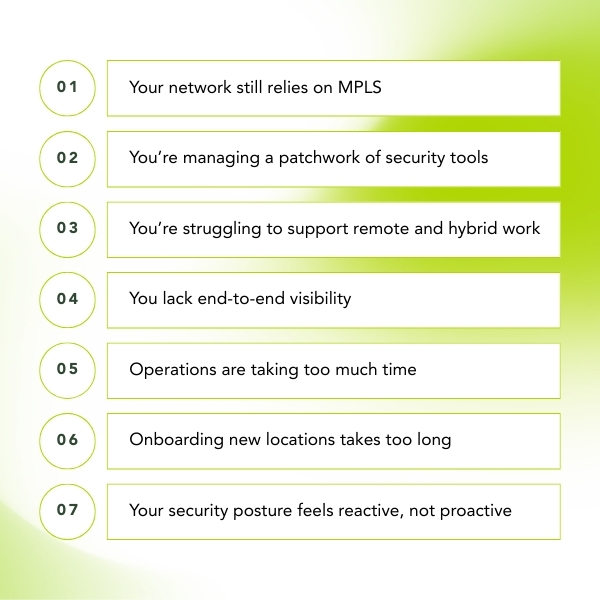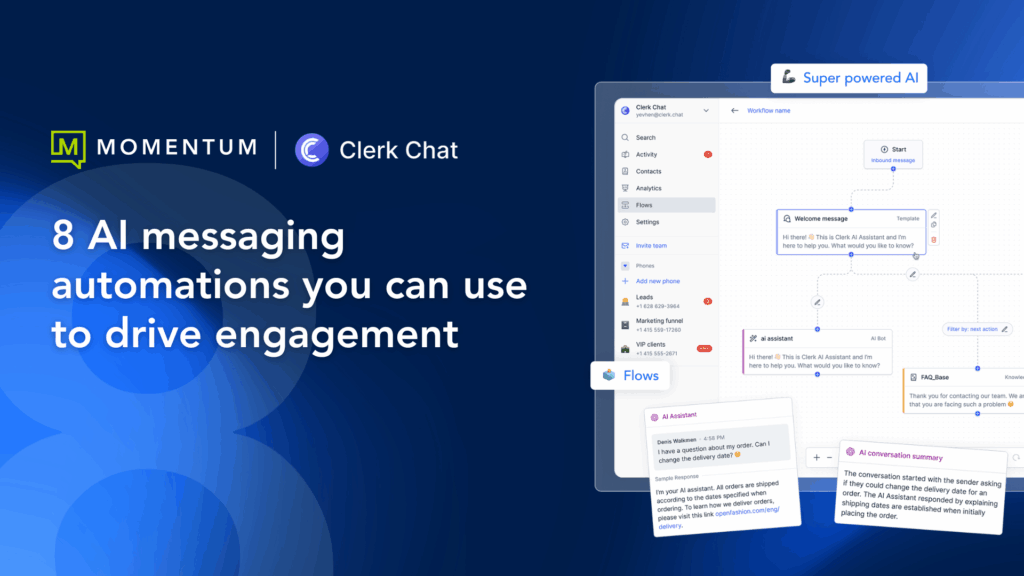At first, things run fine. The VPN handles most connections, and MPLS still links your sites. You’ve patched on enough point products to cover today’s threats. Everything works—until it doesn’t.
Suddenly…
- Performance tanks
- Support tickets spike
- Security feels scattered
And the bigger your business grows, the more tangled it all becomes. You’re not managing your network anymore. You’re managing workarounds.
That’s the moment many IT leaders reach a quiet breaking point: We can’t scale what we’ve built. And we can’t fix it fast enough.

It’s also this point where Secure Access Service Edge (SASE) starts making a lot of sense.
SASE offers a different model, one that unifies networking and security into a single, cloud-delivered platform. But it’s not something you switch to on a whim. Knowing when you’re ready is just as important as knowing what SASE delivers.
Related Content: SD-WAN vs. SASE
What is SASE?
SASE is a cloud-delivered framework that converges network and security functions into one unified platform. Instead of relying on legacy infrastructure like MPLS circuits or standalone security appliances, SASE enables secure, direct-to-cloud connectivity through a global network of distributed PoPs.
That means users, no matter where they are, connect securely to applications and data without needing to backhaul traffic through a central data center or patch together multiple tools. It’s designed for the way businesses operate today: remote teams, SaaS apps, cloud workloads, and constant change.
Core technologies that power SASE include:
- SD-WAN: for intelligent, optimized traffic routing
- Zero Trust Network Access (ZTNA): for secure access without exposing internal networks
- Cloud-based firewall and threat protection: to enforce consistent security policies everywhere
- CASB and DLP: for visibility and control over cloud apps and sensitive data
For many organizations, SASE offers a more scalable, responsive, and secure alternative to the traditional patchwork of VPNs, firewalls, and legacy WANs.
1. Your network still relies on MPLS
MPLS wasn’t built for the way business works today. It made sense when apps lived in the data center and branches needed a private line back to HQ. But those conditions have changed, dramatically.
Now, users are remote, apps are in the cloud, and bandwidth needs shift daily. Trying to make MPLS fit that model means paying too much for too little flexibility.
Here’s how that plays out:
- Want to open a new branch? You’re waiting weeks for circuit provisioning.
- Need better performance for Microsoft 365? You’re backhauling traffic through a hub, adding latency.
- Trying to cut costs? Those rigid carrier contracts don’t leave much room to move.
With a SASE solution, connectivity is internet-based and dynamically routed through the nearest cloud point of presence (PoP). That means faster access to cloud apps, easier scaling, and lower costs without compromising performance or control.
Old model: You deploy an MPLS circuit to a new site, coordinate with your carrier, and wait 30–60 days for activation.
SASE model: You drop-ship a lightweight edge device, and users are securely online the same day through cloud-native provisioning.
2. You’re managing a patchwork of security tools
Security tools tend to multiply over time. As new threats emerge, teams add what they need: firewalls, VPNs, CASBs, remote access gateways, until they’re managing an overlapping collection of products that don’t speak the same language.
Each system brings its own policy engine, alerts, and dashboard. Keeping them aligned takes time your team doesn’t have. And when the stack gets too fragmented, blind spots and inconsistent enforcement start to creep in.
Old model: You manage four or five security tools from different vendors, each with its own policy engine, alerting logic, and dashboard. Aligning them takes manual work, and gaps emerge between the cracks.
SASE model: Security services like ZTNA, firewall, threat protection, and CASB are delivered as a unified platform. Policies are written once and enforced everywhere, reducing complexity while improving consistency and coverage.
Centralized enforcement makes life simpler for your team. Less time spent tuning tools. More time improving posture and getting ahead of risk.
3. You’re struggling to support remote and hybrid work
When work went remote, most IT teams made it work with what they had: VPNs, split tunneling, and full network access for users logging in from anywhere. But that temporary fix is still in place for many organizations, and it’s starting to show.
This leads to:
- Slow performance
- Overprovisioned access
- Limited visibility into who’s connecting to what.
Legacy remote access tools weren’t built for this scale or complexity, and the result is a growing tension between usability and security.
Old model: Users connect to the corporate network over VPN. Performance slows during peak hours. Security teams can’t restrict access to just the apps people need, and onboarding new users takes manual effort every time.
SASE model: Users connect through Zero Trust Network Access (ZTNA) to the nearest cloud PoP. Access is app-specific, not network-wide, and authentication is continuously verified. The experience is fast, consistent, and far more secure.
Supporting hybrid work doesn’t have to mean sacrificing control. With SASE, security is enforced closer to the user and delivered in a way that actually improves performance.
Related Content: Learn more about our carrier-grade network
4. You lack end-to-end visibility
Modern enterprise environments typically include a mix of SaaS apps, branch offices, cloud workloads, and remote endpoints.
Without centralized visibility across it all, even simple questions—like “who accessed what, when?”—can turn into an investigation.
When security and networking tools operate in silos:
- Context disappears
- Incidents take longer to detect
- Policies become inconsistent
- Cross-team coordination stalls
That fragmentation slows your response and leaves teams guessing instead of acting with confidence.
Old model: You rely on separate tools for endpoint monitoring, cloud access logs, network analytics, and threat detection. Piecing together the full picture takes time—and sometimes you don’t find out there was an issue until long after it happened.
SASE model: Visibility is built in. Every user, device, connection, and application is monitored through a centralized control plane. Logs and analytics span your entire environment, making it easier to spot anomalies, enforce policy, and stay ahead of threats.
When teams can see clearly, they can act quickly. SASE turns reactive firefighting into proactive oversight without adding more tools to the stack.
5. Operations are taking too much time
When infrastructure gets too complex, even routine tasks turn into time sinks.
Everything from:
- Updating policies
- Troubleshooting performance issues
- Coordinating between vendors
It all adds up and takes your team away from higher-impact work.
Scripts and clever workarounds help, but they’re band-aids. If your operations feel slow, manual, or vendor-dependent, it’s often a sign that the architecture underneath is getting in the way.
Old model: Making a policy change means logging into multiple platforms, reconciling syntax, and hoping everything syncs. When something breaks, you’re chasing logs across disconnected systems—or waiting on vendor support to catch up.
SASE model: Policy changes, updates, and patches are pushed from the cloud and enforced consistently across users, locations, and workloads. Troubleshooting is centralized, and changes happen in hours—not days.
Fewer moving parts mean fewer delays. SASE gives your team back time to focus on improvements, not just maintenance.
6. Onboarding new locations takes too long
Bringing new branches online shouldn’t be a logistical nightmare. But for many IT teams, each new site triggers a slow-motion process that includes:
- Ordering circuits
- Shipping firewalls
- Configuring everything manually
- Coordinating across vendors to make it all work
Whether you’re expanding into new markets or integrating acquisitions, the delay impacts more than timelines—it slows the business down.
Old model: A new location means sourcing MPLS, waiting weeks for delivery, staging physical hardware, and configuring security on-site. Every delay becomes a blocker for teams trying to get up and running.
SASE model: New sites are onboarded with cloud-native provisioning and lightweight edge devices. Most setups can be handled remotely, and users connect securely to the nearest PoP as soon as they’re online.
What used to take weeks now takes hours, and IT can scale support without scaling complexity.
7. Your security posture feels reactive, not proactive
Most teams don’t want to play catch-up, but the tools they’ve inherited make it hard to stay ahead.
- Alerts come after an incident
- Patches roll out days later
- Threats surface when someone’s already clicked
Most security teams are putting in the work—but their tools keep them stuck in reactive mode. Without shared context across users, traffic, and behaviors, detection lags behind, and response times stretch longer than they should.
Security ends up working backward, chasing what already happened instead of preventing what’s next.
Old model: Security tools log and flag events after they occur. Analysts triage alerts manually, and enforcement happens later—if at all. It’s a cycle that consumes time and still leaves gaps.
SASE model: Threat detection, policy enforcement, and user behavior analytics happen in real time. The platform continuously monitors traffic and identity signals, applying controls at the edge before problems spread.
Proactive protection starts with visibility and speed, something disconnected tools can’t deliver. A unified platform makes it possible to detect threats earlier and act faster, before they escalate.
You’ve outgrown the old model…now what?
Latency issues, tool sprawl, delayed rollouts, and mounting overhead point to a larger shift. As demands evolve, yesterday’s architecture struggles to keep up with today’s pace of work.
Most teams reach this inflection point quietly. First, performance slips. Next, complexity creeps in. Finally, security becomes too reactive, and the tools meant to help start holding you back.
That’s when it’s time to rethink the model.
SASE gives you a clean slate. A single-vendor, cloud-delivered platform that unifies networking and security while also scaling with your business instead of slowing it down.
If you’re starting to see even one of these signs, it’s worth exploring what a purpose-built SASE solution could unlock.



